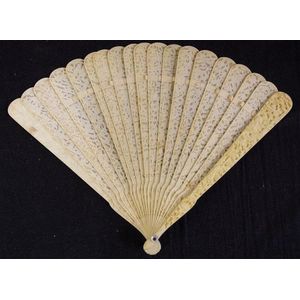Chinese Ivory Brise Fan
You must be a subscriber, and be logged in to view price and dealer details.
Subscribe Now to view actual auction price for this item
When you subscribe, you have the option of setting the currency in which to display prices to $Au, $US, $NZ or Stg.
- Ivory - Ivory is a hard white material that comes from the tusks of elephants, mammoth, walrus and boar, or from the teeth of hippopotamus and whales. The ivory from the African elephant is the most prized source of ivory. Although the mammoth is extinct, tusks are still being unearthed in Russia and offered for sale.
Ivory has been used since the earliest times as a material for sculpture of small items, both in Europe and the east, principally China and Japan.
In Asia ivory has been carved for netsuke, seals, okimono, card cases, fan supports, animals and other figures and even as carved tusks.
In the last 200 years in Europe ivory has been used to carve figures, for elaborate tankards, snuff boxes, cane handles, embroidery and sewing accessories, in jewellery and as inlay on furniture. Its more practical uses include being used for billiard balls, buttons, and a veneers on the top of piano keys.
The use and trade of elephant ivory have become controversial because they have contributed to Due to the decline in elephant populations because of the trade in ivory, the Asian elephant was placed on Appendix One of the Convention on International Trade in Endangered Species (CITES), in 1975, and in January 1990, the African elephant was similarly listed. Under Appendix One, international trade in Asian or African elephant ivory between member countries is forbidden. Unlike trade in elephant tusks, trade in mammoth tusks is legal.
Since the invention of plastics, there have been many attempts to create an artificial ivory - Brise Fan - A brise fan consists of flat ribs that become wider from the rivet to the top, and are held in place by a ribbon threaded through slots at the broad end. They do not have a folding leaf. The earliest brise fans came from China and Japan, and were exported to Europe in large quantities from the 17th century onwards. European-made brise fans, an imitation of the delicate Chinese wooden and ivory fans, were composed of thinly-sliced sticks of bone, horn, tortoiseshell, mother-of-pearl, or ivory that were often elaborately carved, gilded, and painted.
This item has been included into following indexes:
Visually similar items

A Chinese ivory brise fan, the 25 sticks and ends finely carved and pierced with delicate patterns of pagodas, temples and flowers. Length 19.5 cm. Provenance: The Flower Family Collection.

Antique small Chinese carved ivory fan with detailed carved decorated with gentlemen in a garden scene. C:1920, with original fitted box

Finely carved Chinese ivory fan the sticks carved with figures in a landscape, together with 2 smaller ivory examples (faults)

A 19th century ivory, lace and silk fan, the end sticks overlaid with cut brass highlighted with enamels and set with turquoise and foil backed garnets, pinned by a decorative bale, some distress.
